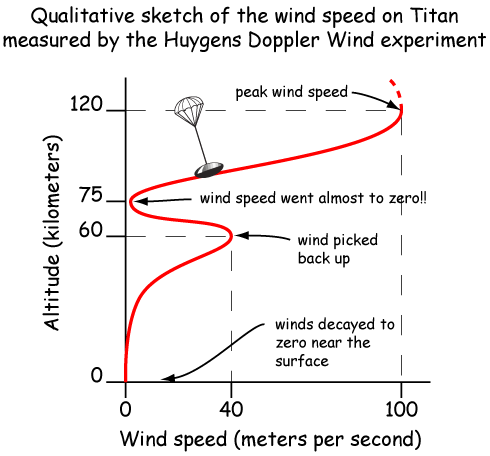Emily Lakdawalla • Nov 08, 2005
An update on the Huygens Doppler Wind Experiment
While I was at the Division of Planetary Sciences meeting in Cambridge in September I had a chance to chat with David Atkinson, who's a member of the Doppler Wind Experiment team on Huygens. They and the other instrument teams have been plugging away at analyzing their data but the publication hasn't made it into print yet -- I understand that the results will eventually be published in Nature, one of these days. Anyway, Dave was kind enough to help me create a schematic sketch of the wind profile that Huygens detected as it descended toward Titan. (We worked on this together on and off over the last couple of months, but I haven't been able to get to it in the last month that I've been working on the new site -- sorry for the delay, Dave.) This sketch doesn't represent actual data -- that will eventually be published in Nature -- but it does hit the high points of what Huygens found during its tumultuous descent, in data that wouldn't exist without the help of the world's radio telescopes. Here's the graph:
The coolest feature in this graph is the way the wind speed dropped very nearly to zero at an altitude of 75 kilometers. It's "pretty remarkable structure," Dave told me. "The wind drops very quickly toward zero, then it picks up again." The team didn't expect that at all. "It was unexpected for virtually everybody. There was one researcher who had one model that kind of hinted that might happen but it was almost universally a surprise to everybody."
This profile assumes that all wind motion was in the zonal direction (east-west). Dave said they're working with the DISR team, trying to figure out how to account for the very tiny meridional (north-south) motion of the probe that happened very close to the surface. He also said that the Channel B wasn't going to be of much help in figuring that component out, because it was driven by an oscillator that was really too unstable for their experiment. The loss of the Channel A does hurt. He said that with the Channel A data they would have had a really high sampling rate that would have permitted them to see events happening on the spacecraft at sub-second time intervals -- the buffeting, twisting, and other turbulent motions of the spacecraft. "It is very frustrating, there is no doubt about it," he said. "At the same time, back on January 14, when we saw our instrument was not turned on, it was devastating, it was crushing. But now, we are ecstatic. What we thought we were going to end up was with nothing at all. So we're frustrated, but it's a very pleased frustration. It's a nice position to be in. We're frustrated, but we have data that we can work with, and we thought we'd have nothing at all."
This graph is also posted on a new page I put together that brings together data from the Huygens landing site. So far I have Cassini orbiter views, DISR views, this graph, and a link to the Titan sounds. I need to add the results from GCMS, SSP, and HASI. I'm having trouble finding images representing that data though -- I guess they are all embargoed until this Nature special issue on Huygens finally gets published.
Support our core enterprises
Your support powers our mission to explore worlds, find life, and defend Earth. You make all the difference when you make a gift. Give today!
Donate

 Explore Worlds
Explore Worlds Find Life
Find Life Defend Earth
Defend Earth


